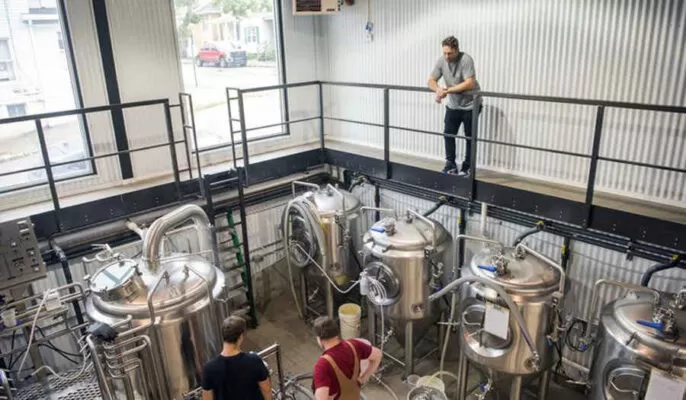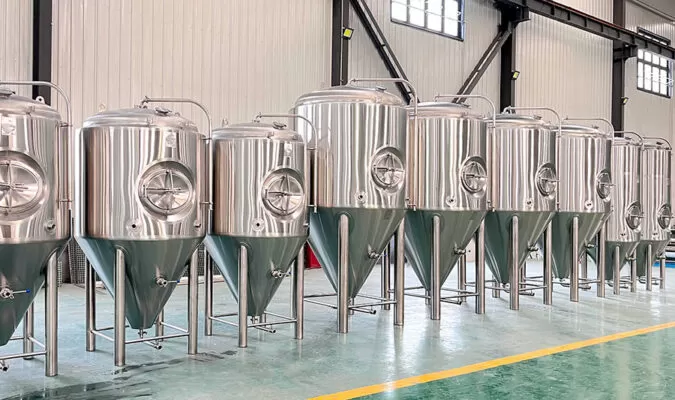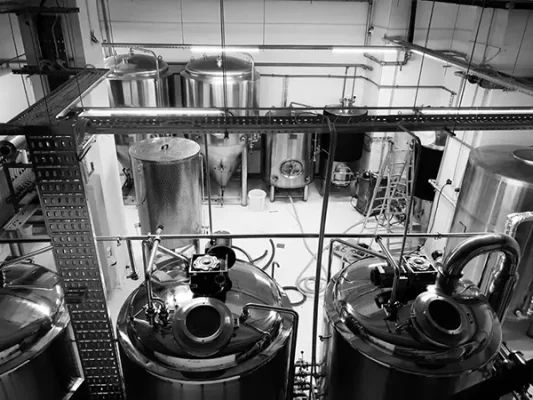Overview of 5000l craft beer brewing equipment
Homebrewing has exploded in popularity over the last decade, with more and more craft beer enthusiasts wanting to make their own brews on a larger scale. A 5000L (1,320 gallon) brewing system is an ideal size for small commercial craft breweries or very dedicated homebrewers looking to take their hobby to the next level.
This guide will explore everything you need to know about 5000l craft beer brewing equipment, from an introduction to the complete brewing system and its components, to reviewing different configurations, suppliers, pricing, installation, operation, maintenance, and more. We’ll help you understand key considerations in choosing 5000L equipment to match your production goals and budget.
Main Components of a 5000l craft beer brewing equipment
A full 5000L brewhouse contains several key pieces of equipment:
| Equipment | Description |
|---|---|
| Mash tun | Stainless steel tank where the milled grains are soaked in hot water to convert starches to fermentable sugars. A mixmash vessel is also commonly included. |
| Lauter tun | Separates sweet wort from spent grains. |
| Brew kettle | The wort is boiled with hops in the brew kettle. Often direct fire or steam heated. |
| Whirlpool | Swirling vessel to separate trub and hops before transferring to the fermenter. |
| Heat exchanger | Cools down the wort after the boiling stage. Plate or shell and tube style. |
| Fermentation tanks | Stainless steel vessels where yeast ferments the sugars into alcohol. Often 3-7 tanks are used for 5000L batches and different beers. |
| Brite tank | After fermentation, beer is carbonated and clarified in the brite tank. |
| Piping, pumps, valves | Automated brewing systems have pipework, valves, pumps and sensors to move liquids between vessels. |
| Control panel | Touchscreen controller to program and operate the brewing sequence automatically. |
| Grain mill | Motorized mill to crack malted grains into grist for the mash tun. |
| Chiller | Liquid or glycol chiller to cool wort and maintain fermentation temperatures. |
Additional equipment like keg washers, canners, bottlers, filtration systems, and quality control tools may be added for a complete production brewery. The brewing system can be customized to match the brewery’s size, brewing style, and budget.
Brewing System Design Configurations
5000L commercial brewing systems are available in different configurations:
Two vessel brewhouses have a combined mash/lauter tun and brew kettle. A separate fermentation tank is used. Simple and compact, but less flexibility.
Three vessel brewhouses have separate mash tun, lauter tun, and brew kettle vessels. Most common and versatile setup.
Four vessel brewhouses add a separate mixmash or mash cooker vessel to optimize mash temperatures and brewing efficiency. Advanced design for large breweries.
Automatic/electric brewhouses are fully automated with timers, sensors, motors and computer control panels. More expensive but simple to operate.
Manual/gas brewhouses are manually operated and heated by natural gas or propane burners. Lower cost but more labor intensive.
Consider ease of use, flexibility, automation, and budget when selecting a brewery configuration. Consult brewhouse manufacturers to select the optimal design.

Choosing a 5000l craft beer brewing equipment Supplier
Reputable brewhouse manufacturers are key to getting a well-designed, efficient, and long-lasting brewing system. Here are tips for selecting suppliers:
- Experienced brewery engineering specialists – Look for established manufacturers who focus on commercial brewing equipment and have in-house engineering teams. They will understand technical brewing requirements.
- High quality stainless steel fabrication – Tanks and piping should be constructed from sanitary grade 304 stainless steel with smooth welds. This prevents contamination and corrosion.
- Customization capabilities – Suppliers should offer customized options for vessel sizes, layout, automation, and accessories to match your brewery goals.
- Local representatives – Suppliers with salespeople and technicians nearby can assist with equipment selection, installation and servicing.
- Turnkey solutions – Many suppliers provide complete turnkey packages with all tanks, pipes, pumps, controls, etc. pre-integrated for faster installation.
- Automation capabilities – Suppliers specializing in automated electric brewhouses with programmable control systems provide simpler operation.
- Installation services – Look for suppliers that can handle equipment delivery, installation, testing, and commissioning services to get the brewhouse running.
- Warranties – Robust equipment warranties provide peace of mind. Ideally 1-2 years on parts and labor.
- Track record – Suppliers with many craft brewery customers have proven experience. Ask for references.
By carefully selecting an experienced 5000L brewing system manufacturer, you can get a high quality customized brewhouse designed for your specific brewing needs.
5000l craft beer brewing equipment Suppliers
Here are some top brewhouse manufacturing companies that offer 5000L systems for craft breweries:
| Company | Location | Details |
|---|---|---|
| Rolec | UK | Custom electric and manual brewhouses, known for automation |
| Specific Mechanical Systems | Canada | Custom brewhouses for craft breweries |
| JV Northwest | USA | Turnkey electric brewhouses with premium components |
| Premier Stainless Systems | USA | Custom fabrication from 2.5 to 10 BBL systems |
| Psycho Brew | USA | Electric brewhouses focused on high efficiency |
| Craftwerk Brewing Systems | Canada | Manual and electric brewhouses |
| Ace Brewing Systems | Canada | Custom modular brewhouses |
| Brewhouse and Restaurant Equipment | USA | Turnkey craft brewery packages |
Many more brewhouse suppliers exist worldwide. Work with a company that understands your production goals, budget, and provides ongoing support.
5000l craft beer brewing equipment Pricing
The total price of a 5000L commercial brewhouse can range widely:
- Manual brewhouses – $100,000 to $220,000
- Electric/automated brewhouses – $250,000 to $450,000
The huge price range depends on:
- Degree of customization
- Level of automation and additional equipment
- Premium materials and components
- Shipping and installation costs
- Supplier’s manufacturing location
For example, a baseline 5000L manual brewhouse with minimal options may cost around $125,000. A fully electric, automated 5000L brewhouse with all the bells and whistles could be over $400,000.
Carefully consider the value to your brewery of customization, automation, advanced features, and quality components vs basic equipment. Get quotes from multiple vendors.
Here are typical price ranges for individual 5000L brewing system components:
| Equipment | Price Range |
|---|---|
| Mash tun | $25,000 – $75,000 |
| Lauter tun | $15,000 – $55,000 |
| Brew kettle | $25,000 – $85,000 |
| Mixmash kettle | $10,000 – $40,000 |
| Fermentation tanks | $4,000 – $15,000 each |
| Brite tank | $15,000 – $30,000 |
| Piping and valves | $5,000 – $15,000 |
| Pumps | $2,000 – $5,000 each |
| Grain mill | $10,000 – $20,000 |
| Chiller | $10,000 – $30,000 |
| Control system | $15,000 – $60,000 |
Expect to pay more for upgraded stainless steel, jacketed vessels, automation, and advanced features. Get itemized quotes for all equipment and installation costs.
Installation and Facility Requirements
Installing a 5000L brewhouse requires significant planning, floorspace, utilities, and infrastructure:
- Floor area – ~1500-2000 sq ft minimum for equipment layout. More for packaging. High ceilings to fit tall tanks.
- Electrical – 400-600V 3 phase power required. 200+ amp service. Panel with room to add capacity later.
- Plumbing – 2-3″ water lines supply, 1-2″ drains. Hot water tank. Process wastewater treatment may be needed.
- Ventilation – Hoods over brew kettle and mash tun, exhaust fans. Cooling may be required.
- Lighting – Bright lighting around all vessels for safe operation. Waterproof LED lights.
- Floors – Sanitary non-slip flooring. Trench drains. Sloped for drainage.
- Access – Doors at least 5 feet wide, high enough for equipment delivery. Staging area for trucks.
- Safety – Emergency eyewash/shower stations. Fire extinguishers. First aid kits.
- Hardware – Stainless steel railings, platforms, ladders, catwalks for safe access.
- Grain handling – Storage bunker or silo. Grain mill access. Dust collection.
Getting permits and inspections for plumbing, electrical, wastewater, ventilation, sprinklers may take months. Hire engineers and contractors experienced in brewery construction.
Operating a 5000l craft beer brewing equipment
Operating a 5000L professional brewing system takes training and experience. Here are best practices:
- Follow manufacturer operating manuals closely, especially for automated systems.
- Check that all equipment, valves, motors, pumps, and controls are functioning properly before starting a batch.
- Measure and weigh all grains, hops, and water salts precisely for recipe consistency.
- Monitor each stage of mashing, lautering, boiling, cooling, and fermentation closely using manual readings or system automation.
- Take careful notes on recipes, batch parameters, and measurements for consistency.
- Adjust water chemistry, temperatures, times, ingredients to fine-tune quality and efficiency.
- Carefully clean and sanitize tanks, pipes, pumps, valves between batches to prevent contamination.
- Wear protective equipment – gloves, boots, goggles for safety when handling hot liquids and chemicals.
- Follow safe lifting techniques when moving heavy equipment and ingredients. Work in teams.
With initial training from the manufacturer and by perfecting operating procedures through experience, a 5000L brewhouse can safely produce consistent quality beer at larger scale.

Maintenance of 5000l craft beer brewing equipment
Proper maintenance keeps a 5000L brewing system running smoothly for years:
- Daily cleaning and sanitizing of all vessels and pipework prevents bacterial buildup.
- Inspect tanks regularly for any leaks, cracks, or damaged insulation. Repair immediately to prevent unsafe issues.
- Lubricate pumps and motors according to manufacturer specifications to prevent premature wear.
- Inspect valves and fittings for wear or leaks. Replace worn o-rings, gaskets, seals promptly.
- Check calibration of temperature, level, pressure sensors regularly. Recalibrate or replace sensors if readings drift.
- Verify grain mill gap spacing for consistent grist particle size. Adjust rollers as needed.
- In automated systems, check control panel, wiring, and electrical connections for faults.
- Test safety relief valves on vessels and pumps annually. Replace if faulty.
- Check brewery equipment warranty status. Schedule manufacturer service if needed.
- Keep detailed maintenance logs on all equipment. Follow preventative maintenance schedules.
With good brewery maintenance habits, you can expect a 5000L professional brewing system to last 15-25 years or more.
Scaling Up Your Brewery Beyond 5000L
As your brewery succeeds and expands, you may outgrow a 5000L system and need to scale up production. Here are options for expanding capacity:
- Add additional 5000L fermentation-only vessels – A simple way to increase beer output without changes to brewhouse size.
- Install larger brew kettle(s) – Upgrading to 7500L or 10,000L kettles increases brewhouse capacity.
- Add a second brewhouse – Dual 5000L brewhouses can double capacity.
- Move to a larger brewhouse – With exponential growth, jumping to a bigger 20bbl+ system may ultimately be needed.
- Partner with a contract brewery – Brewing offsite at a larger brewery is an alternative to capital investment.
- Package onsite vs. kegs – Invest in canning/bottling equipment for wider distribution.
- Expand building space – A larger brewery space allows physical expansion.
- Upgrade utilities, wastewater – Increased electrical service, ventilation, water, wastewater capacity enables growth.
With careful planning and staged equipment investments, 5000L brewhouses offer excellent scalability for growing craft breweries.

FAQ
Here are answers to some frequently asked questions about 5000L professional brewing systems:
What size batches can a 5000L brewhouse produce?
- Typically 10-20 hectoliter (8.5-17 BBL) batches. Output depends on hours brewed per day.
What yearly beer production capacity does a 5000L system allow?
- Around 1000-5000 hectoliters per year depending on hours operated. Enough for a taproom and modest distribution.
What raw materials are needed for 5000L batches?
- Around 1500-2000 lbs of grain. 25-50 lbs hops. Water, yeast, sanitizers. Grain silo recommended.
How much space does a 5000L brewhouse require?
- Approximately 1500-2000 sq ft. More for separate packaging hall. Height to fit 3-4 meter tall tanks.
How many people are needed to operate a 5000L system?
- 2-3 trained brewers. Additional packaging staff. Brewers should have commercial experience.
What are the power and utility requirements?
- 400-600V, 3 phase, 200A+ electrical service. 2-3″ water supply lines. Drains for 2000 gal+ batches.
What are the advantages of 5000L automated brewhouses?
- Consistent recipes and quality beer. Reduced labor. Overall easier operation.
What are the disadvantages of 5000L automated systems?
- Much higher equipment cost. Complexity requires trained staff. Maintenance intensive.
How long does it take to install a 5000L brewhouse?
- 2-6 months typical. Building preparation and permitting can add significant time.
In Summary
This guide covers all the key considerations in purchasing and operating a 5000L professional craft brewing system. A complete brewhouse allows scaling up production while maintaining quality and consistency. Work closely with suppliers to customize equipment to match your brewing goals and budget. Careful planning for installation, operation, maintenance, and future expansion will lead to long-term success.




